Did you find this article helpful for what you want to achieve, learn, or to expand your possibilities? Share your feelings with our editorial team.


Mar 31, 2022
VISION & IDEAAccelerating society’s transition to renewable energy with charging-dischargingservices
Solving energy problems with a view to global deployment
-
Automotive & Life Solutions Div.Kotaro Saito
Saito joined DENSO in January 2013 after working for a consumer electronics company.He is currently engaged in development operations for energy-related systems.
Global warming is a worldwide issue, and people everywhere are making major changes in energy usage, including switching to renewable energy sources.
For some time now, DENSO Corporation has been involved in energy management in the mobility field and beyond through home energy management systems (HEMS), electricity charging-discharging equipment, and other such technologies. Based on its wide-reaching knowledge and experience, the Company is striving to realize a carbon-neutral society through services on the infrastructure side of electric vehicle (EV) charging-discharging systems.
Contents of this article
Tackling energy-related issues based on automotive know-how
The shift toward renewable energy is already underway on a global scale, and auto makers too are increasingly joining the push to make EVs the industry norm. I believe that DENSO is launching new energy management businesses; how has your company been involved with energy management in the past?
Kotaro Saito:Most people think of DENSO as being involved mainly in automobile component manufacturing, but for many years now we have actually been active in energy management systems and technologies inside vehicles, aiming to reduce environmental impact. By leveraging those technologies, we believe we can contribute to society as a whole, through automobiles and in many other areas. Accordingly, we have been actively expanding and developing our energy-related product line.
One example is leveraging our experience in car air-conditioning systems to develop central AC systems for entire buildings. We also used our heat pump technologies to create “EcoCute,” the world’s first household-use water heater using natural refrigerant.
In 2011, we announced our home energy management system (HEMS), which enables households to use energy more efficiently. By monitoring electricity consumption, the system helps users notice wasteful energy usage and thus encourages energy-saving habits and actions.
We improved this system in 2014 by adding a function for automated energy management, which utilizes surplus solar power to automatically charge EVs and supply electricity for household-use via storage batteries and charger equipment. This helps customers become more aware of excess electric-power generation amounts and reduces the time and effort required for adjusting power management manually.
In 2011, the HEMS communication protocol “ECHONET Lite” was established as an official standard by the Ministry of Economy, Trade and Industry (METI), after which a number of companies began releasing compatible devices. These devices can act as go-betweens enabling users to remotely control their household HEMS using a smartphone or tablet.
In 2019, DENSO released its new V2H charging-discharging systems. “V2H” is short for “vehicle to home”—in other words, these systems are designed to enable EV batteries to be used as electric power sources in customers’ homes. The EV batteries store power generated by solar panels, and that electricity can then be used to power devices in the home as well as the EV itself.
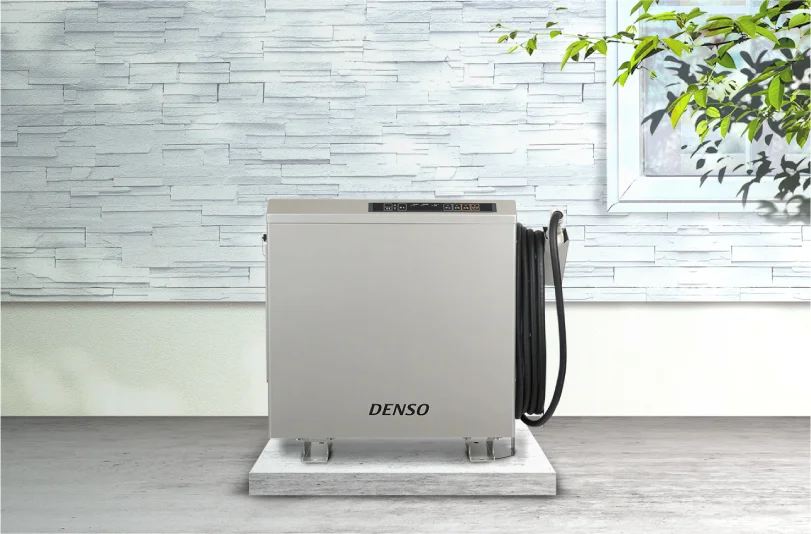
What prompted you to embark on the V2H charging-discharging system project?
Saito:As you know, 2011 was the year of the unprecedented earthquake and tsunami disaster in Tohoku, and in recent years we’ve seen increased power outages caused by typhoons and other natural disasters. After reflecting on these events, we wanted to give customers a greater sense of security by providing a way to use electricity from EVs for the home in case of an emergency situation while also boosting the value of the vehicles as products. These were our goals in developing charging-discharging systems.
Can V2H charging-discharging system equipment be used in conjunction with HEMS?
Saito:A V2H charging-discharging system on its own carries out energy management operations.
However, using it together with a HEMS brings new possibilities. If, for example, the weather forecast for the following day is sunny, then photovoltaic generation will be good, and this electricity can be used to power the home while also charging one’s EV. If the forecast is for rain, on the other hand, the vehicle will be charged at night when power-company rates are lower, and its battery can serve as a backup energy source the following day if the electricity supply is not enough. Currently, based on our experience with HEMS and V2H charging-discharging systems, we are developing new EV charging-discharging services.
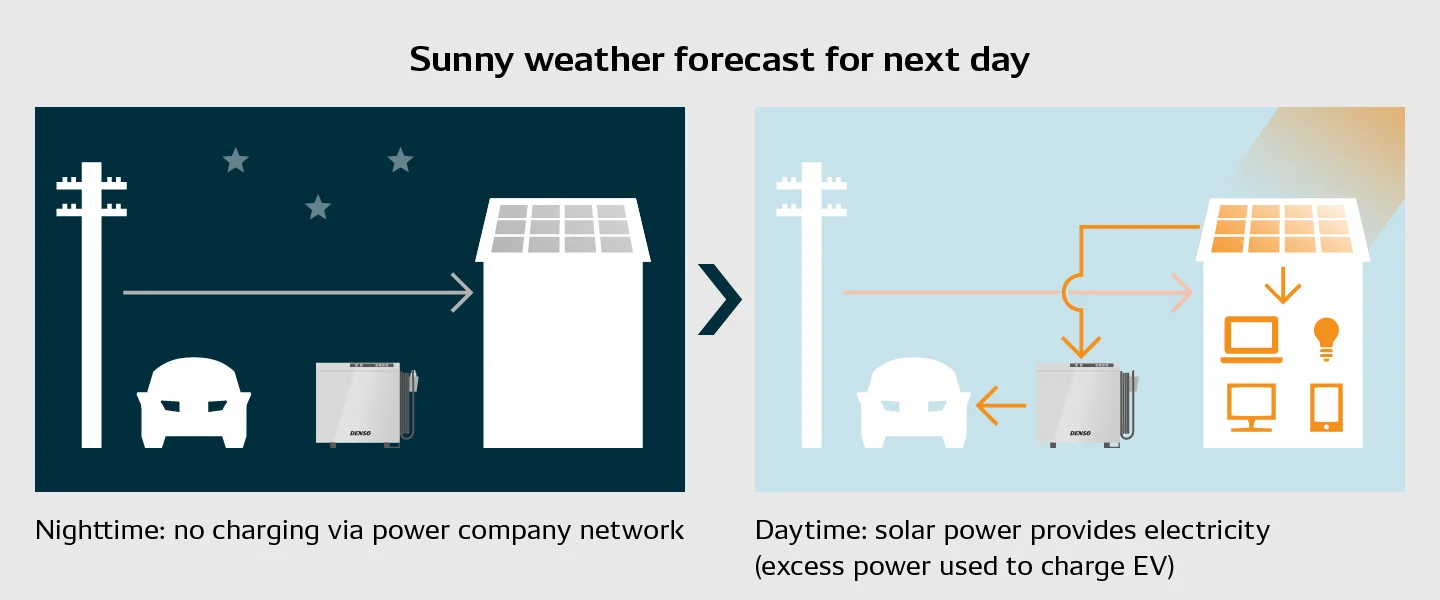
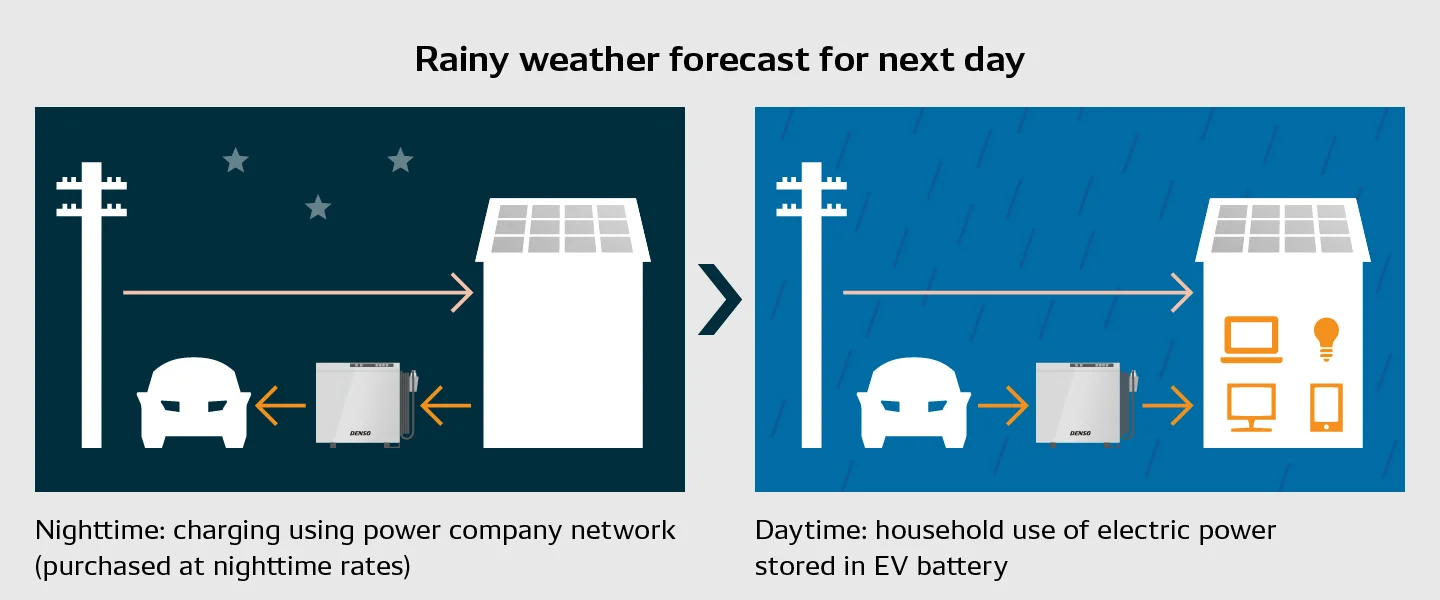
Centralized management of EV charging-discharging services
Which types of services will you provide specifically?
Saito:Thus far, DENSO’s HEMS have been geared toward single-family detached homes, but we’re now expanding the scope of our EV charging-discharging services so that we can provide systems for apartment complexes, office buildings and other such locations.
We are developing systems that provide management and control to realize efficient charging and discharging of EVs connected to chargers in these buildings’ parking lots. With offices or apartments, it would be a problem if workers or residents were unable to use their vehicles whenever they wanted, due to poor charging timing. Ideally, our system will enable users to drive their EVs whenever needed, use nighttime power rates and solar power generation to save on electricity costs, and also discharge electricity stored in EV batteries for other uses as necessary. And, of course, if a crisis such as a power outage or network overload were to occur, backup electric power could be supplied from the EV batteries.
Because DENSO has a lot of experience with designing power charging-discharging systems that minimize wear and tear on EV batteries, we will apply our knowledge to these new systems and services.
What prompted you to start planning these new services?
Saito:With gasoline-powered cars, the user must fill up at the gas station frequently, so they are constantly thinking about how much fuel is left in the tank. With EVs, as long as people’s homes and workplaces are outfitted with readily available charging equipment, users will no longer have to worry about running out of fuel—or charged electricity—and can use their car without concern.
Market studies have shown that many consumers would like to buy an EV, but issues remain that hinder dissemination. Forty percent of consumers surveyed said they live in apartments, but only a small number of those buildings had the proper charging equipment. Additionally, a number of companies have shown interest in purchasing EVs, but many of them are worried about potential problems such as increased electricity costs or the car not being sufficiently charged when needed for company use.
To achieve widespread EV dissemination in the market, each of these issues must be addressed and solved on the infrastructure side of operations.
I’ve heard a lot of talk about virtual power plants (VPPs) lately. My understanding is that this type of system provides centralized control for solar power generation, storage batteries, EVs, household electricity usage and so forth, controlling an area’s power generation facilities and storage batteries as one single, virtual power plant. How will you connect your charging-discharging services with such VPPs?
Saito:This is an area with big potential. The auto industry aims to switch from fossil fuels to electric power to achieve a carbon-neutral society, but this transition must be also made in areas outside of automobiles. If electric power used to charge EVs is generated using fossil fuels, then clearly it is not an eco-friendly approach, which is why people throughout society agree that we must switch from fossil fuels to renewable energy.
However, renewable energy can be unreliable. When poor weather prevents effective solar power generation, or conversely when excess electric power is generated, it’s important to find ways to use this energy and absorb the excess and shortfall without putting a strain on the power supply network. To this end, VPP systems will play a huge role, and within this context EV batteries are very useful. The possibilities inherent in this approach motivate us in our work at DENSO.
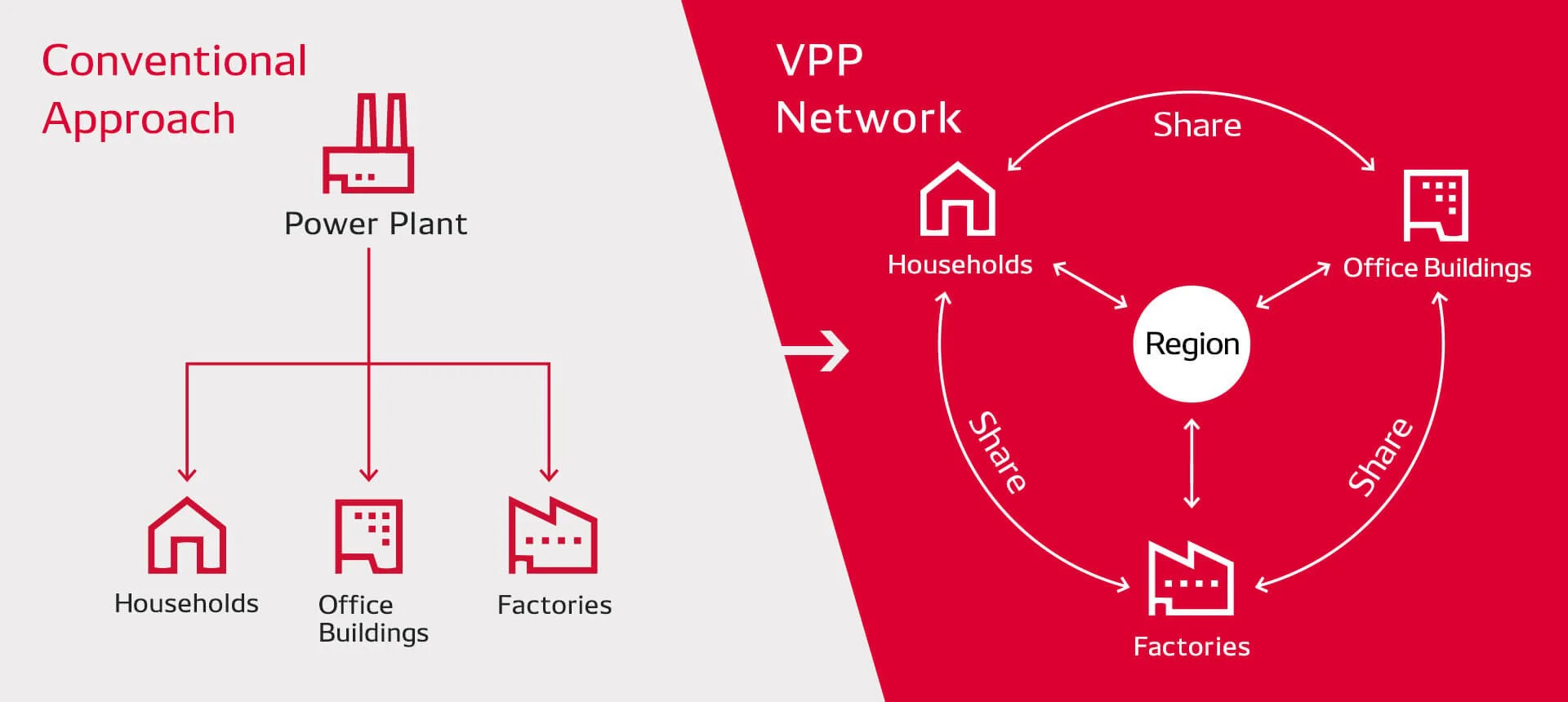
How will you organize your services in this area?
Saito:Services will be divided into two main elements. The first is edge computing: DENSO is developing IoT terminal devices that can connect and communicate with our V2H charging-discharging systems and other equipment. These IoT devices come equipped with electric power measurement and remote control functionality.
The second element is servers, which collect and bring together information from numerous IoT devices to analyze it, then issue instructions for optimal charging and discharging at each location.
Server algorithms are particularly important here.
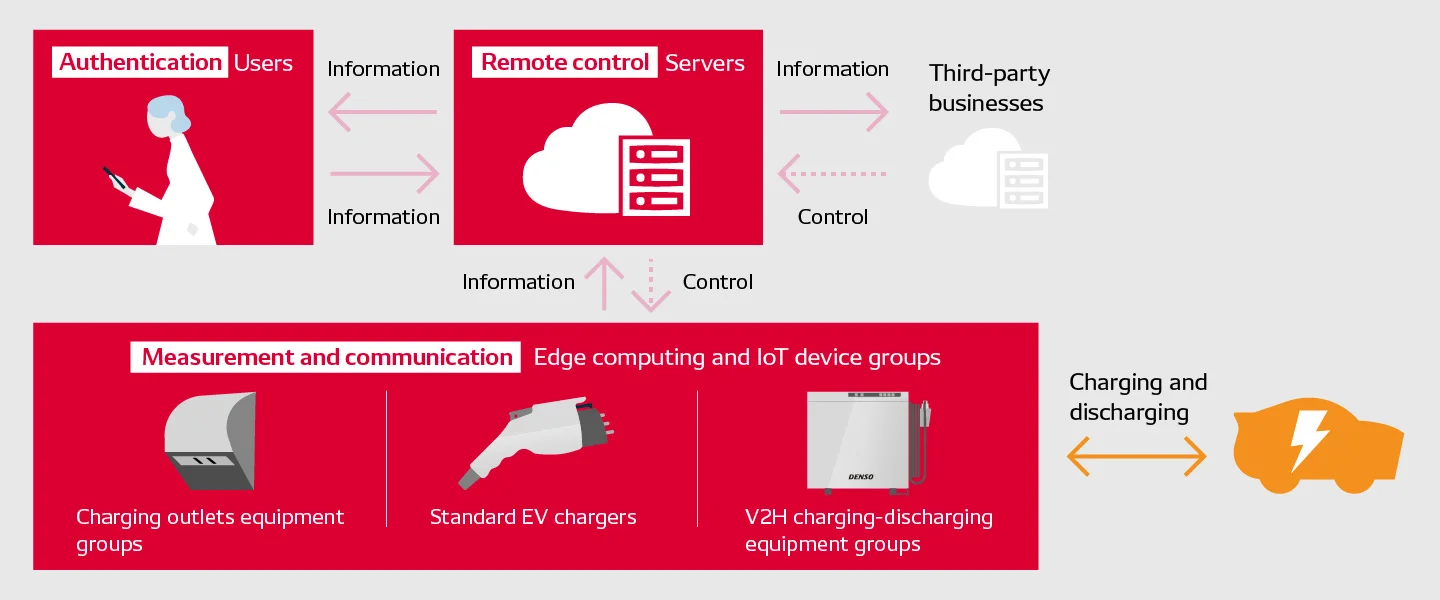
You already make use of energy management in HEMS and V2H charging-discharging systems. How will your new services differ?
Saito:We actually use many of the same technologies in regard to nighttime power network utilization, solar power generation and other means of reducing power-company network usage during peak-rate hours. We’re also utilizing various DENSO technologies for proposed solutions in areas such as electric power measurement.
The main difference with this new framework is the use of multiple vehicles within the overall equation. EV usage varies greatly from user to user: some people drive them primarily in the morning, and some use their vehicles mostly in the afternoon or evening. If we tried to charge and discharge vehicles based on the same schedules and patterns, we would fail to tailor services to individual users. Therefore, we must develop useful new algorithms for our energy management systems.
For our new services, we’re pursuing system development in two phases. Phase one entails thoroughgoing deployment of energy management in discrete categories, such as for apartments or for offices. Within each category, we will develop a system for efficient energy usage that does not cause any inconveniences to users. The second phase is the creation of discharging systems that can be used to supply society as a whole when necessary and meet its electric power needs.
Solving energy problems with a view to global deployment
In other words, software is key.
Saito:In the automotive field, DENSO has developed a lot of technologies for systems used both inside and outside of the vehicle. Our mission has always been to use our technologies to make customers happier. In order to deploy our technologies in products and services as quickly as possible, good software has been vital.
Which types of human resources do you look for in your EV charging-discharging system development operations?
Saito:Experience with servers is most important to improve the performance of systems in this field. We also prefer that personnel have experience with software, cloud networking and the like. However, the biggest factor is a strong motivation to help solve society’s energy-related problems. We hope to overcome environmental problems by transitioning to renewable energy and to provide greater convenience to customers. We have a strong sense of mission and a passion to achieve those goals for the sake of society.
People who can establish system requirements, deploy systems, carry out project management and make customers happy, and enjoy this process together with the team, will help us to improve our services.
Will you be releasing these services outside of Japan?
Saito:We’re starting out domestically in Japan, but we definitely plan to expand them globally at some point because energy-related problems are not limited to this country alone. The idea of transitioning to renewable energy has already caught on in Europe in particular, and even in Asia where fossil fuels are central, the ideas are starting to become more widespread. Every country and region that wants to switch to renewable energy and popularize EVs faces the same challenges when trying to coordinate with their existing power supply networks.
DENSO has numerous overseas centers of operation where we work closely with locals in every country, so this project gives us an opportunity to become more active on a global scale.
I imagine DENSO’s energy management systems, VPP systems and the like will be of interest to a wide range of potential business partners, even in areas outside of shared housing and offices.
Saito:Yes, and that’s why we plan to identify the needs of various potential partners and customers, design specifications and actual systems based on these, and then pursue proof-of-concept (POC) testing. Our efforts involve various operations, such as reflecting user feedback in performance improvements, within an integrated project framework. It’s all really fun and fascinating. For an engineer, delivering the results of one’s hard work directly to customers is truly rewarding.
Follow the link below for more information on DENSO’s lifestyle-related products and application examples:
COMMENT
Changing your "Cant's" into "Cans"
Where Knowledge and People Gather.

